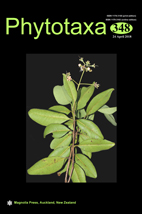Abstract
Loxospora cristinae sp. nov. is a sterile corticolous lichen characterized by sorediate, thin, smooth, folded, cracked-areolate and non-verruculose to partly verruculose thalli, soralia soon becoming confluent and the production of 2’-O-methylperlatolic acid. The new species is similar to the recently described L. assateaguensis and L. confusa, which are also sterile and contain 2’-O-methylperlatolic acid. Loxospora assateaguensis can be readily distinguished from the new species by the thallus, which is distinctly verruculose almost from the edge and pustular, and the circular soralia developing apically on the thalline verrucae, and from L. confusa by the presence of granular isidia. The distinction of all three species and their phylogenetic position are also corroborated by molecular approaches using mtSSU and ITS markers. The new species has been found so far only in well preserved forests in Poland.

